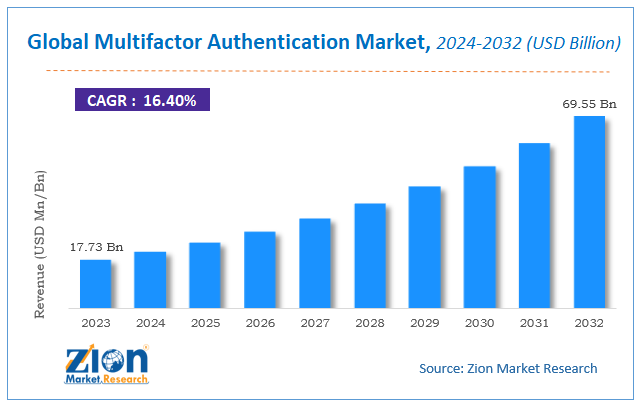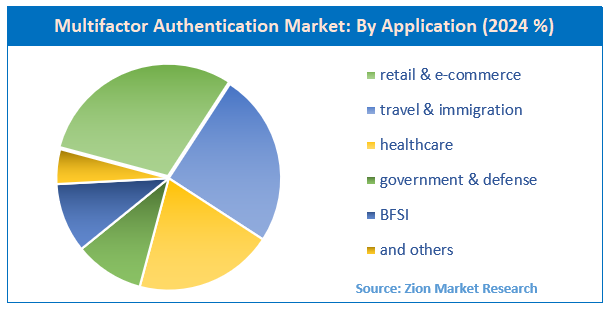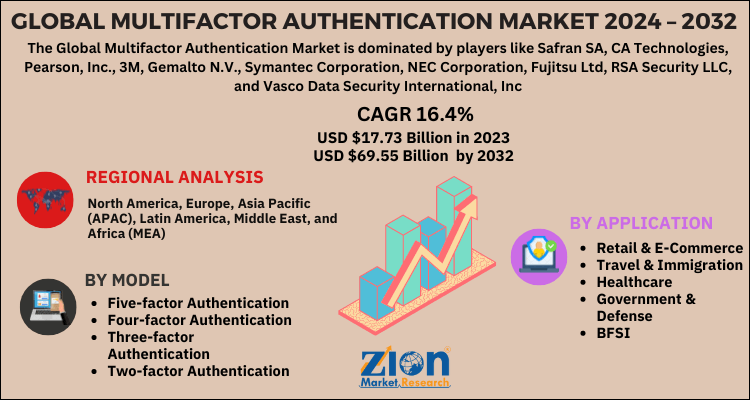Multifactor Authentication Market Size, Share, Trends, Growth and Forecast 2032

Multifactor Authentication Market By Model (five-factor authentication, four-factor authentication, three-factor authentication, and two-factor authentication.), By Application (retail & e-commerce, travel & immigration, healthcare, government & defense, BFSI, and others) And By Region: - Global And Regional Industry Overview, Market Intelligence, Comprehensive Analysis, Historical Data, And Forecasts, 2024-2032
| Market Size in 2023 | Market Forecast in 2032 | CAGR (in %) | Base Year |
|---|---|---|---|
| USD 17.73 Billion | USD 69.55 Billion | 16.4% | 2023 |
Description
Multifactor Authentication Market Insights
According to the report published by Zion Market Research, the global Multifactor Authentication Market size was valued at USD 17.73 Billion in 2023 and is predicted to reach USD 69.55 Billion by the end of 2032. The market is expected to grow with a CAGR of 16.4% during the forecast period. The report analyzes the global Multifactor Authentication Market's growth drivers, restraints, and impact on demand during the forecast period. It will also help navigate and explore the arising opportunities in the Multifactor Authentication industry.
Key Insights
- As per the analysis shared by our research analyst, the multifactor authentication market is anticipated to grow at a CAGR of 16.4% during the forecast period (2024-2032).
- The global multifactor authentication market was estimated to be worth approximately USD 17.73 billion in 2023 and is projected to reach a value of USD 69.55 billion by 2032.
- The growth of the multifactor authentication market is being driven by rising need for advanced security solutions to combat increasing cyber threats, identity theft, and data breaches.
- Based on the model, the five-factor authentication segment is growing at a high rate and is projected to dominate the market.
- On the basis of application, the retail & e-commerce segment is projected to swipe the largest market share.
- By region, North America is expected to dominate the global market during the forecast period.
Global Multifactor Authentication Market: Overview
Multifactor authentication (MFA) is an advanced security system. It is installed where there is a need for more than one authentication process to provide access. The surge in the number of validation processes to reduce the probability of security breaches such as hacking and data theft has driven the demand for such authentication systems. The multifactor authentication system consists of an amalgamation of logical, biometric, and physical procedures to pass the security system.
Global Multifactor Authentication Market: Growth Factors
The foremost factor driving the global multifactor authentication market is the growing network security threats coupled with increasing demand for reliable and advanced authentication systems. Furthermore, the surging usage of smartphones with built-in authentication technology and rapidly growing e-commerce pace has propelled the global multifactor authentication market growth.
The involvement of cloud computing in the smart solutions is helping the service providers to reduce the maintenance cost of software and hardware-based models. Many companies are turning to cloud computing due to the ease of installation & upgradation, improved scalability & enhanced readability, and pay per use features and hence these features are positively shaping the trajectory of the global multifactor authentication market.
The growing investment activities in cloud technologies, adoption of enterprise mobility, and enterprise mobility are anticipated to boost the market growth vigorously during the forecast period.
The growing number of data breaches and cyber-attacks has led organizations to spend heavily on cyber security to protect their business. Legacy network and defense sector are substituted with upcoming technologies to stop hackers from gaining network access.
Moreover, several other factors like increasing pressure of compliances regarding data security, strict rules & regulations regarding data security, and growing adoption of BYOD things among businesses have bolstered the global multifactor authentication market during the forecast period.
Global Multifactor Authentication Market: Segmentation
The global multifactor authentication market can be segmented into model, application, and region.
By Model, the market can be segmented into five-factor authentication, four-factor authentication, three-factor authentication, and two-factor authentication.
Two-factor authentication holds the largest share in the global multifactor authentication market. This model helps the organizations to authenticate the identification of users digitally with the help of several parameters like possession-based factors, knowledge-based factors, and inherence-based factors. Multi-factor authentication has widespread usage in different sectors as they facilitate data protection and enhance security. Service providers and technology firms are innovating and deploying several solutions that cater to the operational efficiencies of the organizations and thus boosting the global multifactor authentication market growth.
By Application, the market can be segmented into retail & e-commerce, travel & immigration, healthcare, government & defense, BFSI, and others. The BFSI segment holds hegemony owing to the growing adoption of MFA solutions that enables organizations and businesses to secure their transactions to avoid data loss and frauds in the online transactions.
The healthcare industry is anticipated to witness huge growth during the forecast period due to the proliferation of the sector coupled with the growing adoption of digital services across the sectors.
Recent Development
- Accenture enhanced its IAM capabilities in 2025 with the acquisition of IAMConcepts, a Canadian firm specializing in identity governance and customer identity & access management.
- In 2025, Jamf announced its agreement to acquire Identity Automation for approximately USD 215 million in cash, integrating identity management—including MFA policy enforcement—into its endpoint and device management ecosystem.
- CyberArk broadened its identity security portfolio in 2024 by acquiring Venafi, a leader in machine identity management, for roughly USD 1.54 billion. The deal marked CyberArk’s expansion into certificate lifecycle management and non-human identity protection.
- Continuing its strategic push, CyberArk acquired Zilla Security in 2025, strengthening its capabilities in Identity Governance & Administration (IGA) and enhancing governance around MFA and access controls.
- In December 2023, Okta acquired Spera Security, an identity security platform focused on threat detection and posture management—key components in reinforcing MFA effectiveness and policy enforcement.
- In 2021, One Identity (a Quest Software division) acquired OneLogin, a cloud-native IAM provider with MFA support, significantly expanding its access management offerings.
In 2022, JumpCloud acquired MYKI, a password manager and authenticator app, to bolster its authentication suite with enhanced MFA and credential management capabilities.
Multifactor Authentication Market: Report Scope
| Report Attributes | Report Details |
|---|---|
| Report Name | Multifactor Authentication Market |
| Market Size in 2023 | USD 17.73 Billion |
| Market Forecast in 2032 | USD 69.55 Billion |
| Growth Rate | CAGR of 16.4% |
| Number of Pages | 209 |
| Key Companies Covered | Safran SA, CA Technologies, Pearson, Inc., 3M, Gemalto N.V., Symantec Corporation, NEC Corporation, Fujitsu Ltd, RSA Security LLC, and Vasco Data Security International, Inc |
| Segments Covered | By model, By application and By Region |
| Regions Covered | North America, Europe, Asia Pacific (APAC), Latin America, Middle East, and Africa (MEA) |
| Base Year | 2023 |
| Historical Year | 2018 to 2022 |
| Forecast Year | 2024 - 2032 |
| Customization Scope | Avail customized purchase options to meet your exact research needs. Request For Customization |
Multifactor Authentication Market Dynamics
Key Growth Drivers
The Multifactor Authentication (MFA) market is experiencing significant growth, primarily driven by the escalating frequency and sophistication of cyberattacks, such as phishing, ransomware, and identity theft. Traditional password-based authentication is no longer sufficient to protect sensitive data and systems, and organizations are increasingly adopting MFA as a foundational security measure. This is further fueled by stringent regulatory requirements and compliance mandates, such as GDPR and HIPAA, which require companies to implement robust security protocols to protect customer data. The widespread adoption of cloud computing, remote work models, and bring-your-own-device (BYOD) policies has expanded the attack surface, creating an urgent need for secure access to corporate networks from diverse and unmanaged devices, which MFA effectively addresses.
Restraints
Despite the clear demand, the MFA market faces several significant restraints. One of the primary challenges is the perceived inconvenience and user resistance to an additional authentication step. Users may find the process cumbersome and time-consuming, which can lead to low adoption rates and a reliance on less secure workarounds. The high initial cost of implementing and integrating complex MFA solutions, particularly for legacy systems, can be a major financial barrier for small and medium-sized enterprises (SMEs). Furthermore, a significant portion of the market is still reliant on less secure methods like SMS-based one-time passwords, which are vulnerable to attacks like SIM swapping, thereby undermining the security promised by MFA.
Opportunities
The Multifactor Authentication market is ripe with opportunities for innovation and expansion. The transition towards passwordless authentication, which uses biometrics, security keys, or push notifications to eliminate the need for a traditional password, is a key growth avenue. This approach not only enhances security by removing the weakest link but also improves the user experience. The integration of Artificial Intelligence (AI) and Machine Learning (ML) is another major opportunity, as these technologies can enable "smart" and adaptive authentication that analyzes user behavior and context to dynamically adjust security requirements. This allows for a frictionless experience for low-risk activities while enforcing stricter controls for high-risk ones. The expansion of MFA into new sectors like the Internet of Things (IoT) and automotive also presents a significant growth opportunity.
Challenges
The Multifactor Authentication market faces a number of complex challenges. A major challenge is the constant evolution of MFA bypass techniques, such as authentication fatigue attacks, where cybercriminals repeatedly send push notifications to trick users into approving a fraudulent login. The industry must also contend with the inherent technical complexity of integrating MFA with a fragmented ecosystem of legacy applications and diverse IT infrastructure. The lack of a universal regulatory framework and standardization for MFA can create confusion for organizations operating globally and complicate the process of ensuring compliance. Lastly, the industry must address the data privacy and security concerns associated with collecting and storing biometric data, which can be a major point of contention for both users and regulators.
Global Multifactor Authentication Market: Regional analysis
North America holds the largest share in the global multifactor authentication market owing to the technological advancements coupled with the proliferation of smartphones, the high adoption rate for numerous digital services, and enhanced network connectivity in the region. Moreover, the increasing cases of cyber-attacks are boosting the adoption of multifactor authentication in the region. Furthermore, the presence of prominent market players in the region is driving regional growth significantly.
Asia Pacific is anticipated to witness huge growth with high CAGR during the forecast period due to the growing expense on connected devices, increasing investment activities in IoT & cloud technologies, and surging demand for digital services in the region.
Global Multifactor Authentication Market: Competitive Players
Some of the significant players in the global multifactor authentication market are
- Safran SA
- CA Technologies
- Pearson
- Inc.
- 3M
- Gemalto N.V.
- Symantec Corporation
- NEC Corporation
- Fujitsu Ltd
- RSA Security LLC
- Vasco Data Security International,Inc
The Global Multifactor Authentication Market is segmented as follows:
By Model
- Five-Factor Authentication
- Four-Factor Authentication
- Three-Factor Authentication
- Two-Factor Authentication
By Application
- Retail & E-commerce
- Travel & Immigration
- Healthcare
- Government & Defense
- BFSI
- Others
Global Multifactor Authentication Market: Regional Segment Analysis
- North America
- The U.S.
- Canada
- Europe
- France
- The UK
- Spain
- Germany
- Italy
- Rest of Europe
- Asia Pacific
- China
- Japan
- India
- South Korea
- Southeast Asia
- Rest of Asia Pacific
- Latin America
- Brazil
- Mexico
- Rest of Latin America
- Middle East & Africa
- GCC
- South Africa
- Rest of Middle East & Africa
What Reports Provides
- Full in-depth analysis of the parent market
- Important changes in market dynamics
- Segmentation details of the market
- Former, on-going, and projected market analysis in terms of volume and value
- Assessment of niche industry developments
- Market share analysis
- Key strategies of major players
- Emerging segments and regional markets
- Testimonials to companies in order to fortify their foothold in the market.
Table Of Content
FrequentlyAsked Questions
The foremost factor driving the global multifactor authentication market is the growing network security threats coupled with increasing demand for reliable and advanced authentication systems. Furthermore, the surging usage of smartphones with built-in authentication technology and rapidly growing e-commerce pace has propelled the global multifactor authentication market.
Some of the significant players in the global multifactor authentication market are Safran SA, CA Technologies, Pearson, Inc., 3M, Gemalto N.V., Symantec Corporation, NEC Corporation, Fujitsu Ltd, RSA Security LLC, and Vasco Data Security International, Inc.
North America holds the largest share in the global multifactor authentication market owing to the technological advancements coupled with the proliferation of smartphones, the high adoption rate for numerous digital services, and enhanced network connectivity in the region.
Asia Pacific is anticipated to witness huge growth with high CAGR during the forecast period due to the growing expense on connected devices, increasing investment activities in IoT & cloud technologies, and surging demand for digital services in the region.
HappyClients
Zion Market Research
Tel: +1 (302) 444-0166
USA/Canada Toll Free No.+1 (855) 465-4651
3rd Floor,
Mrunal Paradise, Opp Maharaja Hotel,
Pimple Gurav, Pune 411061,
Maharashtra, India
Phone No +91 7768 006 007, +91 7768 006 008
US OFFICE NO +1 (302) 444-0166
US/CAN TOLL FREE +1 (855) 465-4651
Email: sales@zionmarketresearch.com
We have secured system to process your transaction.
Our support available to help you 24 hours a day, five days a week.
Monday - Friday: 9AM - 6PM
Saturday - Sunday: Closed







